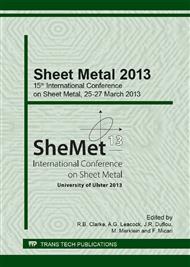p.372
p.381
p.389
p.397
p.407
p.415
p.423
p.429
p.436
Numerical Simulation of Welding Thin Titanium Sheets
Abstract:
Different titanium grades are used in aircraft construction because of titaniums unique properties. These materials are mostly joined by different welding methods. Electron beam welding technology is often used in the aircraft industry to join structural elements made of titanium alloys. The goal of the work is a numerical analysis of the electron beam welding process applied to joining thin titanium sheets. The analysis was performed using finite element method, FEM. Temperature distribution, size of heat affected zone (HAZ), depth and width of fusion zone were determined for the assumed heat source model. Thermo-mechanical (TMC) simulation of the electron beam welding process using FEM is presented in the paper. The joining of two sheets, one made of commercially pure titanium Grade 2 and the other made of titanium alloy Grade 5 (Ti6Al4V), is analysed in the work. For the sheet welding process distributions of temperature, effective stress, and sheet deformation were calculated.
Info:
Periodical:
Pages:
407-414
Citation:
Online since:
April 2013
Authors:
Price:
Сopyright:
© 2013 Trans Tech Publications Ltd. All Rights Reserved
Share:
Citation:


